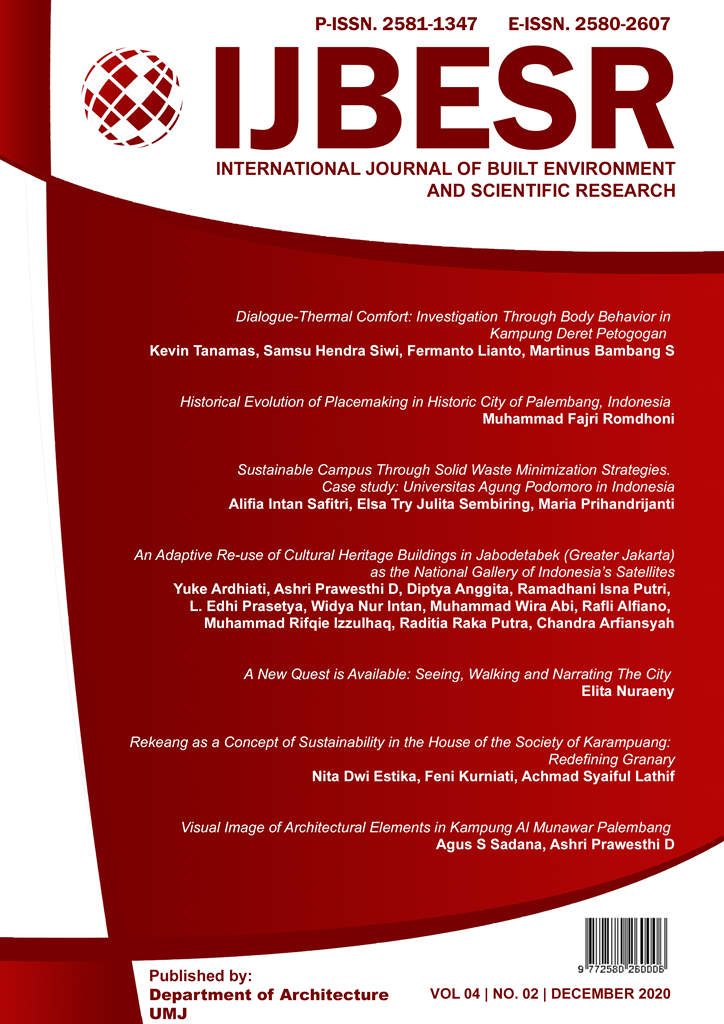Rekeang as a Concept of Sustainability in the House of the Society of Karampuang: Redefining Granary
DOI:
https://doi.org/10.24853/ijbesr.4.2.137-146Keywords:
Granary, Karampuang traditional village, network, rekeang, sustainable developmentAbstract
Whether granaries in traditional communities have survived or being neglected due to modern progress has been widely discussed. However, the discussion remains fragmented and isolated solely on the granary itself, without considering the possibility of its more comprehensive relations. This paper aims to delve into the granary roles in Karampuang, a traditional village in South Sulawesi, to understand how the granary (in the local term 'rekeang') functions and sustains while facing modernization. The inquiry focuses on the interactions between rekeang and farming products, which further results in an understanding of interrelationships between rekeang and its surroundings: 1) domestic spaces, 2) family house units, and 3) with other rekeangs. Each relationship reveals that rekeang has a vital role, besides storing up farming products, it also serves as the key to sustaining the community, especially in cultural and ecological contexts. In the end, the paper proposes a critical insight of 'granary as a network,' which might provide an alternative approach to achieve sustainable development in traditional environments.References
H. Hanan, "Tradition and Modernization in Indonesian Vernacular Houses," in Southeast Asian Houses: Expanding Tradition, R. J. Seo, Ed. The Republic of Korea: Seoul Selection, 2017.
H. Hanan, "Individual Practice and Cultural Context in the Transformation of Batak Toba House," Asian J. Environ. Stud., vol. 3, no. 7, pp. 99–108, 2018, doi: 10.21834/aje-bs.v3i7.272.
I. Widiastuti and F. Kurniati, "Modernization and vernacularity in the tradition of Minangkabau architecture of the West Sumatra in Indonesia," ISVS E-journal, vol. 6, no. 2, pp. 22–31, 2019.
J. Servaes, "Introduction: From MDGs to SDGs," in Sustainable Development Goals in the Asian Context, Singapore: Springer Nature, 2017, pp. 1–21.
N. AlSayyad, "The End of Tradition, or the Tradition of Endings?," in The End of Tradition?, N. AlSayyad, Ed. London: Routledge Taylor & Francis Group, 2004, pp. 1–28.
P. S. Brandon and P. Lombardi, Evaluating Sustainable Development in the Built Environment, Second edi. Chichester: John Wiley & Sons, Ltd, 2011.
T. Williamson, A. Radford, and H. Bennetts, Understanding Sustainable Architecture. London: Spon Press, 2003.
N. Booth, "Foreword," in Sustainable Development Goals in the Asian Context, J. Servaes, Ed. Singapore: Springer Nature, 2017, p. v.
A. Le Duc, "Religious Environmentalism and Environmental Sustainability in Asia," in Sustainable Development Goals in the Asian Context, J. Servaes, Ed. Singapore: Springer Nature, 2017.
M. Vellinga, "Vernacular architecture and sustainability: Two or three lessons...," in Vernacular Architecture: Towards a Sustainable Future, 2015, pp. 3–8.
G. Domenig, "Consequences of functional change: granaries, granary-dwellings, and houses of the Toba Batak," in Indonesian houses: tradition and transformation in vernacular architecture, Singapore: Singapore University Press, 2004.
R. Waterson, The living house: an anthropology of architecture in South-East Asia. Singapore: Oxford University Press, 1990.
A. Asis, “Nilai Budaya dalam Upacara Adat Mappogau Hanua di Karampuang, Kabupaten Sinjai, Provinsi Sulawesi Selatan,” Walasuji, vol. 6, pp. 381–396, 2015, doi: 10.1017/CBO9781107415324.004.
A. Nasrullah, “Tradisi Upacara Adat Mappogau Hanua Karampuang di Kabupaten Sinjai (Studi Kebudayaan Islam),” Universitas Islam Negeri Alauddin Makassar, 2016.
Mithen, O. Sampebua, Sunardi, and G. D. Dirawan, "Model local wisdom to preserve the environment in South Sulawesi and West Sulawesi Indonesia," Man India, vol. 95, no. 4, pp. 1041–1050, 2015.
A. Hafid, “Sistem Kepemimpinan pada Komunitas Adat Karampuang di Kabupaten Sinjai,” Wa, vol. 5, no. 1, pp. 77–91, 2014.
Magister Teknik Arsitektur Unhas, “Laporan Arsitektur Vernakular Rumah Adat Karampuang,” Makassar, 2013.
J. W. Creswell, Research design: qualitative, quantitative, and mixed methods approaches. California: Sage Publications, Inc, 2008.
W. L. Neuman, Social Research Methods: Qualitative and Quantitative Approaches. London: Pearson Education Limited, 2014.
B. Wiryomartono, "The politics of development in Indonesia: The aesthetic culture and power play in architecture and urban design," Int. J. Urban Sci., vol. 16, no. 2, pp. 203–223, 2012, doi: 10.1080/12265934.2012.701442.
H. M. Mathur, "Tribal Land Issues in India: Communal Management, Rights, and Displacement," in Land and Cultural Survival: The Communal Land Rights of Indigeneous Peoples in Asia, J. Perera, Ed. Metro Manila: Asian Development Bank, 2009, pp. 165–192.







